https://hebrewhammerblog.com/2018/1...-clinic-aar-polymer80-roland-special-edition/
Slightly edited review below (I eliminated some discussion of my PF940C's performance that people here will presumably be uninterested in.):
Slightly edited review below (I eliminated some discussion of my PF940C's performance that people here will presumably be uninterested in.):
(Full disclosure: I got a small class discount for AARs I previously wrote. I didn’t ask for it, and I’d still be taking their classes without it. The amount of money in question is trivial to my situation, and thus had trivial impact on this AAR – or so I hope.)
Green Ops is one of the few advanced training outfits here in the DC area. It’s run by Mike Green, who’s been on the Primary and Secondary podcast quite a number of times. (And, again, if you’re not listening to P&S, turn it on right now while you’re reading this AAR so you can enrich your life.) Mike has a very impressive bio, which you can read on the Green Ops website.
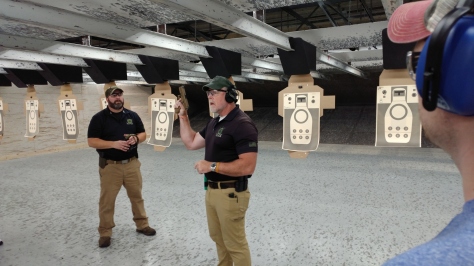
Instructors for this class were Mike, Brett, and Josh. Brett’s bio is also up on the website, but he’s got a military and LEO background. Josh’s isn’t, but he was some kind of a Navy chief who was apparently hanging around with Mike during his contractor days. Suffice it to say, both of them are entirely competent and did a great job of pushing the class to perform. As I’ve noted previously, the instructors often flavor the class, maybe even without knowing it – this one felt a lot more “military” than the Defensive Carbine I clinic did. Doesn’t matter much either way, but it’s fun to see the difference.
I bring up the instructor qualifications not because they treated themselves like they were a big deal (they didn’t!), but because there’s a lot of training outfits out there that don’t really have that kind of pedigree. I was talking to a friend the other day about another semi-local training outfit I won’t name that he loved (it’s not FPF or Jedi), and I pointed out that not only did their lead instructor come off as a pompous d-bag, but he had fewer than five years in the IDF infantry as his entire professional shooter resume before becoming an instructor. Military or LEO service isn’t the only way to be an amazing shooter and/or instructor, but if that’s your prime qualification, I expect to see a substantial amount of it… again, the Green Ops guys deliver.
The class is at the NRA HQ range. This is a great facility that prohibits photos outside of classes, so… look at their website for photos. It was a bit cold on the range when we got out there initially, but doing a little pistol gunnery warmed me up enough to not notice it much half an hour in. Note to self: wear long sleeves next time! The clinic ran from 6-10:30PM, and we got out mostly on time (I think the RSOs were tired of us running super late).
I always like to post up a description of the class so you can see what it’s supposed to be about:
This clinic covers the defensive use of a full-sized to compact-sized pistol. You will improve your pistol handling skills with a strong emphasis on the fundamentals. This clinic covers the defensive use of a full sized to compact sized pistol. Students will improve their pistol handling skills with a strong emphasis on the fundamentals. Students will learn self-diagnostic skills to continue development of their own personal performance.Well, this is pretty straightforward, right? If defensive carbine I was “carbine 102”, this class is “pistol 102”. You’re supposed to come in knowing how to draw and not shoot yourself, and maybe even hit a target, but this course covers the kinds of stuff that comes afterwards.
My Fauxland Special. Didn’t use the comp at class.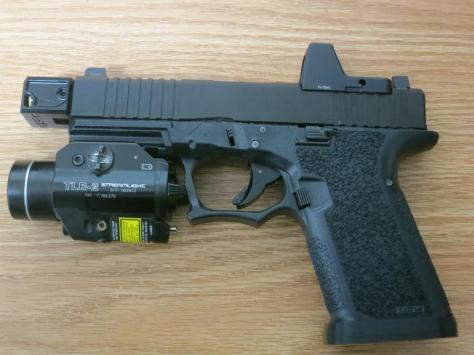
I didn’t do a full run-through of everyone in the class, but it seemed like it was mostly 9mm striker-fired plastic fantastics like the Glock and M&P. I decided to try something new, and ran my “Roland Special” Polymer80 PF940C 9mm build… this is a PF940C with a Brownells slide, RMR, Ameriglo night sights, TLR-2, BCA threaded barrel, and Glock internal parts (including a minus connector). This handicapped me a bit because I’m just not as fast with an optics gun as an irons gun, but it also gave me a chance to run it hard and get some instruction on how to correct my technique. Holster was an RHT competition holster, and the mag carrier was a Bladetech. Speaking of which, I mostly ran Magpul mags… those 21rd GL9 pmags are friggin’ awesome for classes. Ammo was mostly IMI EX-STAR JHP rounds; I like these, but my new competition focus has me leaning towards heavier or more powerful stuff depending on whether I’m using a comp (think 150gr Federal Syntech or 124gr NATO-spec ammo).
I’m in the midst of writing an article about “how to be a good student”, but I’ll reiterate again: make sure your stuff works before the class. I pulled the comp off my gun because it was just not reliable with it using the ammo I had. My RMR was zeroed, and I confirmed that zero before class. My (six) mags were full, and my rig was tested. There was only one student who experienced what I assume were real failures with their gun, so it seemed like everyone was squared away. Your experience is always going to be better with reliable equipment that you have tested as a system.
Speaking of which… class composition. It was all guys this time, albeit still relatively diverse within that. Some guys were relatively sharp, others were a little newer (albeit still competent). My mind is drawn back to the P&S episode on training, where someone (it might have even been Mike) talked about situations where you had a strong relay, and a somewhat weaker relay, and how to handle them. I might be suffering from observer bias, but it very much felt like that was the situation during class. I’m not sure if it was purposeful or if it was just accidental sorting, but the Green Ops team handled it great, with very little slow-down.

The class starts off with classroom time. This is literally the same presentation as was given in the Defensive Carbine I clinic. A big portion of this is some legal theory on justified use of lethal force. I want to give Brett and Mike some credit here; it feels like they were trying to push through this portion of the class a little faster than in previous classes to get us to the range quicker. That is not to say it wasn’t covered in some good detail – it was, and I always catch some nuance that maybe I hadn’t fully considered before.
Green Ops has five tools they promote to becoming a better shooter:
THIS STUFF WORKS. It works even better if you’re disciplined about it. I discovered my real-life shooting times were not as fast as my dry-fire times. That’s not great, but training let me know where I needed to focus to help bring those things together (including getting some weighted dry-fire mags). Even in spite of that, I would say that I still did reasonably well in class from that practice… it really shows. And, if nothing else, it gives confidence to run those drills. Shooting from barriers kneeling or doing an el prez? I didn’t even feel nervous going first. It was something I had done before. It was no big deal.
- Training
- Dry-fire using a par timer
- Competition
- Live fire
- Video of yourself doing 1-4

Honestly, it also turns you into kind of an asshole. You’re looking at people drawing and reloading and are like… why are you going so slow? I get it if you want to go slow when you’re lining up your sights perfectly. Probably not necessary at 7yds, but whatever. But getting that gun up there? That should be fast. OK, they’re doing it because they’re not confident in their draw, and fair enough, I don’t want them shooting themselves, but it’s just so obvious now. The humbling thing is that you know you were just like that not so long ago, and maybe you still look just like that to anyone with real skill, like a USPSA master-class shooter. Maybe dry-fire is as much about the mental drive as the physical skill, in its own way.
When the classroom portion is over, everyone heads out to the range (or, if you’re me, to the bathrooms and THEN the range). The uncasing procedure this time was “make sure no one’s forward, and then get your (unloaded) gun out and holstered”, which is vastly preferable to the old “everyone come to the line with your cases and spend 10 minutes on this procedure”. I don’t know if this is the new normal, but if it is, huzzah, I enjoy being treated like a responsible adult. I am vaguely surprised they didn’t just tell us to gear up in the booths, which would seem like the safest option of all of them.
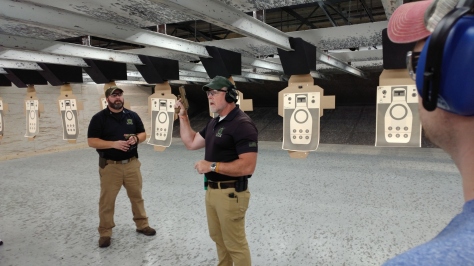
The first drills in the class are dry-fire draws. This is completely skills assessment to make sure you can draw without shooting yourself. Everyone pulled this off without too much drama, so it was on to the live-fire.
I’ve read on various Interwebz sites that you’re not supposed to divulge the exact class contents. IMHO, that is utter nonsense – the course content is not the secret sauce. Most intermediate pistol classes have roughly the same content. The quality of instruction is the secret sauce! But here’s some stuff we did in no particular order:
The target used was the pistol-training.com target. These targets are set up pretty nicely for a combination of precision shooting, along with a nice 7″-ish circle in the middle. Most of the shooting was at 7yds, with a little bit of precision shooting at 3yds. Suffice it to say, the emphasis was on speed more than distance shooting.
- Draw and shoot a couple times at close range.
- Draw and shoot a couple times at normal range.
- Slide-lock reloads.
- Malfunction-clearing.
- Barrier-shooting.
- El Prez without the turn.
The malfunction-clearing was a surprise highlight of the class. Green Ops teaches you to diagnose and then apply specific (simple) fixes. This gives you the ability to clear double feeds, stovepipes, etc. a lot faster than the universal methods other places teach. We practiced doing some of the malfunction-clearing, and it was quite valuable to do it (rather than just see it).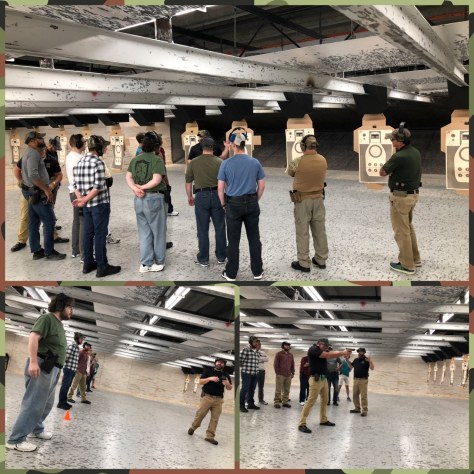
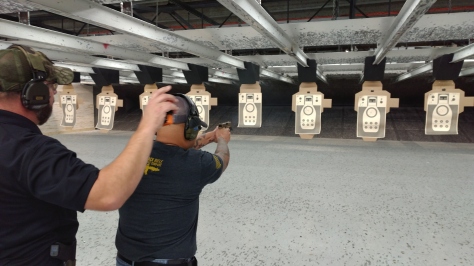
Total round count was somewhere in the 100-150 range, I think. That may sound low, but it’s because every round you fired was in the service of some sort of goal. One thing I’ve noticed as I’ve developed as a shooter is how much ammo you can waste accomplishing nothing… that’s not the case here.
As I alluded to above, I was a lot slower than I wanted to be, because I was still getting used to running an optics pistol. Put simply, you have to screw up badly to totally lose the front sight on a pistol, but it’s real easy to lose a red dot with poor recoil management or draw indexing. Brett provided some terrific advice on how to get the optic on the target and how to raise the gun that I’m excited to start trying out in dry-fire. I also think I need to use weighted SIRT mags, because the weight kind of threw me off (I dry-fire reload empty mags – oh well). I will also note that recoil control was a lot easier when using a comp, but without ammo that would reliably cycle the gun with it, that was not an option. I’m going to be investigating whether NATO-spec ammo can reliably do the job in the future, or if I need to start hand-loading 9mm major.
On the plus side, I may have been slower to get my shots off, but my accuracy was really good. You can’t misalign your sights with a red dot… it’s either on target when the trigger breaks, or it’s not. With the minus connector, it’s very easy to pull the trigger back without the sight moving much. Once I’ve figured out my draw index and recoil management a little better, I suspect I’ll be able to shoot it better than irons.
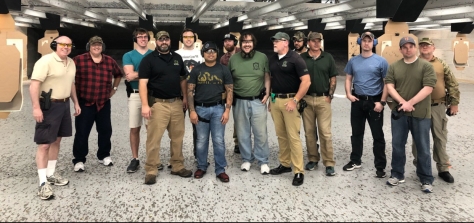
At the end of every class, Green Ops always asks: did you have fun? Did you learn something? Did you get your money’s worth? As always, the answer to those three questions is most certainly yes. It’s always fun putting rounds down range with purpose. I learned how to run my optics gun better. And the price they charge – $155 – is cheap for the quality of instruction you’re getting at a really nice indoor facility.
The only real recommendation I have is that it might be interesting to experiment with a smaller one-relay pistol class with a heavier focus on action shooting and higher round counts, even if that meant the class tuition cost would be higher and the experience bar was tougher. The 4.5-hour clinic format is excellent for being able to push people hard without the exhaustion of an all-day outdoor class, and I’d like to see them exploit it more.
Conclusions:
I always walk away from a Green Ops class knowing more than I started with, and having a firm idea of what I need to do to grow as a shooter. To me, that’s the mark of an excellent class. The instructor cadre is relentlessly professional, and they will tell you exactly what you need to hear, even if you don’t always want to hear it. They will also tell you to not believe a single word of what they say until you verify it with a pro-timer against other approaches. That confidence is well-deserved.
The Roland Special I used in class, built on the Poly80 PF940C frame, is really quite compelling, and I do think optics guns are the way of the future. However, the compensator aspect makes them rather finicky to deal with in terms of ammo, and they do require a higher level of training to use effectively in terms of competitive shooting. It’s a bit unintuitive that sticking a comp and a reflex sight on a rifle makes it much easier to use, whereas doing the same to a pistol makes it harder (at least initially), but that’s how it plays out for me.









